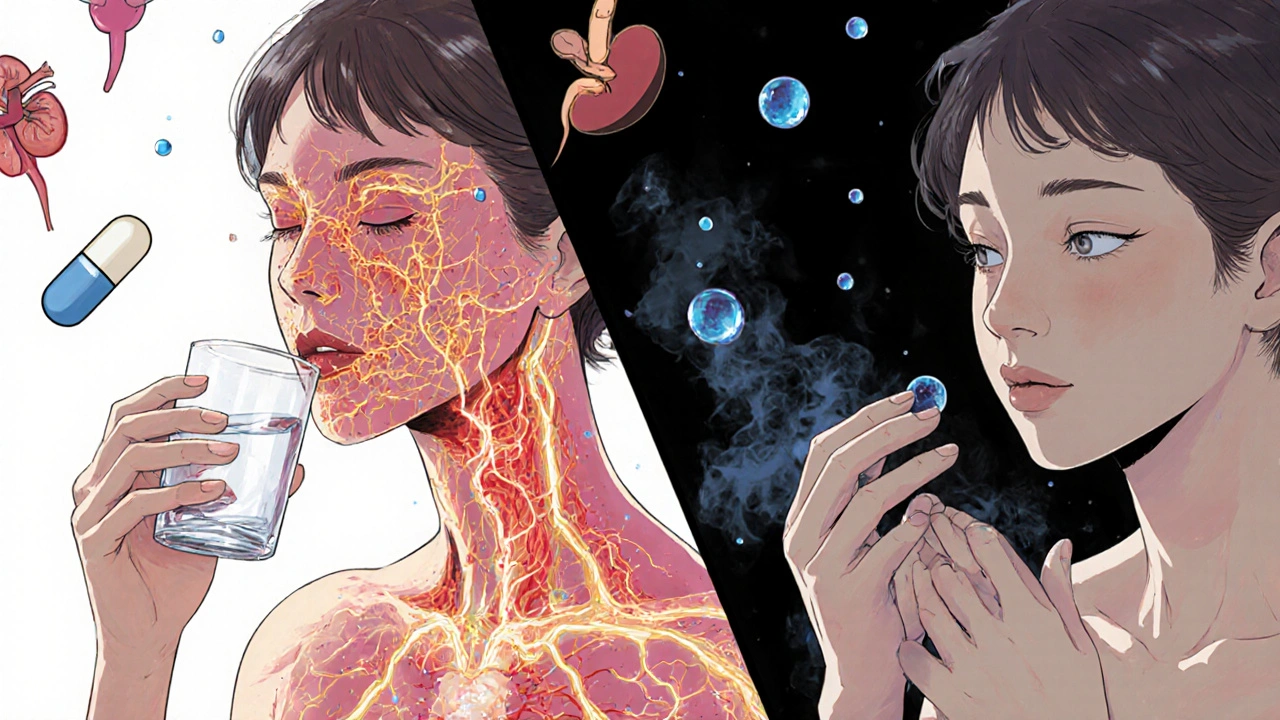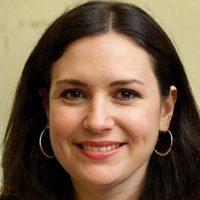Spironolactone for Acne: Oral vs. Topical Treatment

Spironolactone isn’t a typical acne drug. You won’t find it in the same aisle as benzoyl peroxide or retinoids. But for women with stubborn hormonal acne-especially around the jawline, chin, and lower face-it’s become one of the most effective options doctors reach for. The big question? Should you take it by mouth or apply it straight to your skin? The answer isn’t simple, and it depends on what your body needs, not just what’s trendy.
Why Spironolactone Works for Acne
Acne isn’t always about dirty skin or too much oil. For many women, it’s driven by androgens-male hormones like testosterone that spike during puberty, menstrual cycles, or due to conditions like PCOS. These hormones tell your sebaceous glands to overproduce oil, clog pores, and trigger inflammation. Spironolactone blocks androgen receptors in the skin and reduces the amount of free testosterone circulating in your blood. It doesn’t kill bacteria or dry out your skin like other acne meds. It goes after the root cause.
Studies show that about 70% of women with hormonal acne see noticeable improvement after 3 to 6 months of oral spironolactone. One 2021 review in the Journal of the American Academy of Dermatology found that doses between 50mg and 200mg daily led to a 50% or greater reduction in acne lesions in most patients. That’s comparable to isotretinoin in some cases-without the same level of side effects.
Oral Spironolactone: The Gold Standard
Oral spironolactone has been used off-label for acne since the 1980s. It’s not FDA-approved for this use, but it’s widely accepted in dermatology. Doctors usually start at 25mg to 50mg per day and increase slowly, depending on how you respond and tolerate it.
Here’s what you can expect:
- Timeline: It takes at least 2 to 3 months to see results. Don’t give up if your skin looks worse at first-it’s common.
- Effectiveness: Works best for adult female acne, especially if it flares before your period. It also helps reduce excess facial hair in some cases.
- Side effects: Frequent urination (it’s a diuretic), breast tenderness, menstrual irregularities, dizziness, and low blood pressure. Rarely, it can raise potassium levels, so your doctor will likely check your bloodwork every few months.
It’s not safe during pregnancy. If you’re sexually active, you must use reliable birth control. Spironolactone can cause serious birth defects in male fetuses. Even if you’re not planning to get pregnant, it’s a non-negotiable safety step.
Topical Spironolactone: The New Kid on the Block
Topical spironolactone is newer, less studied, and not yet available as a standard prescription in most countries. But compounding pharmacies in the U.S., Canada, Australia, and New Zealand can make custom creams or gels with spironolactone concentrations between 1% and 5%.
Here’s how it stacks up:
- How it works: Applied directly to acne-prone areas, it blocks androgens right where they’re causing trouble-without affecting your whole body.
- Benefits: No systemic side effects. No need to worry about potassium levels, dizziness, or menstrual changes. Great for people who can’t take oral meds due to kidney issues, low blood pressure, or pregnancy concerns.
- Limits: It only treats the areas you apply it to. If your acne is widespread, it won’t help much. It’s also not as potent as oral. Studies show about 30-40% improvement in lesions after 3 months, compared to 70% with oral.
One 2023 pilot study in Clinical, Cosmetic and Investigational Dermatology tested a 5% topical spironolactone gel on 42 women with mild-to-moderate facial acne. After 12 weeks, 76% reported less redness and fewer breakouts. But 20% saw no change at all. It’s promising, but not a magic bullet.

Oral vs. Topical: The Real Comparison
Here’s how the two forms compare side by side:
| Feature | Oral Spironolactone | Topical Spironolactone |
|---|---|---|
| Effectiveness | High (70%+ improvement) | Moderate (30-40% improvement) |
| Time to Results | 2-6 months | 3-6 months |
| Side Effects | Systemic: frequent urination, low BP, menstrual changes, high potassium | Local: dryness, redness, mild irritation |
| Use During Pregnancy | Contraindicated | Potentially safer, but not fully studied |
| Cost | $5-$20/month (generic) | $50-$120/month (compounded) |
| Accessibility | Widely available by prescription | Only through compounding pharmacies |
Oral wins for severe or widespread acne. Topical is better if you’re looking for a gentler option, have mild acne localized to your chin and jaw, or can’t tolerate oral meds. Some dermatologists even combine both-oral for internal control, topical for spot treatment.
Who Should Avoid Spironolactone Altogether
Not everyone is a candidate. Avoid spironolactone if you:
- Have kidney disease or are on dialysis
- Have Addison’s disease
- Are pregnant or planning to become pregnant
- Have high potassium levels (hyperkalemia)
- Are taking NSAIDs like ibuprofen long-term (can raise potassium further)
- Are male (it can cause breast growth and sexual side effects)
Men with acne should look elsewhere. Spironolactone isn’t effective for male-pattern acne and carries too many risks.
What to Do If It Doesn’t Work
Spironolactone isn’t a cure-all. If you’ve tried it for 6 months with no improvement, talk to your doctor about:
- Switching to a higher oral dose (up to 200mg/day, under supervision)
- Adding a topical retinoid like tretinoin
- Trying a different hormonal therapy like combined oral contraceptives (e.g., Yaz, Estrostep)
- Considering isotretinoin for severe, scarring acne
Some women need a combo approach. One patient I worked with took 100mg oral spironolactone and used a 2% topical retinoid nightly. Her acne cleared by month 5. She still gets occasional breakouts, but nothing like before.

Real Talk: Managing Expectations
Spironolactone won’t give you perfect skin overnight. It’s not a quick fix. It’s a long-term management tool-like wearing glasses for vision. You take it because it works, not because it’s easy.
Also, don’t stop suddenly. If you discontinue oral spironolactone, your acne can come back hard and fast. Many women need to stay on a low dose (25-50mg) indefinitely to keep breakouts under control.
And yes, you’ll still need to use gentle cleansers, sunscreen, and non-comedogenic moisturizers. Spironolactone helps from the inside, but your skincare routine still matters.
Where to Get It
Oral spironolactone is easy. Ask your GP or dermatologist. They’ll write a prescription, and your local pharmacy can fill it. In New Zealand, it’s available as a generic under the brand name Aldactone or just as spironolactone.
Topical spironolactone is trickier. You’ll need a compounding pharmacy. In Wellington, places like Pharmacy 2000 or Healthcare Compounding can make it. Bring your prescription and ask for a 1-5% cream or gel. Don’t try to make your own-it won’t be safe or effective.
Final Thoughts
Oral spironolactone is the proven, powerful choice for hormonal acne. Topical is a promising alternative for those who can’t handle the side effects or only have localized breakouts. Neither is perfect. But for many women, they’re the best shot at clear skin without the harshness of isotretinoin or the frustration of endless spot treatments.
Start with oral if your acne is moderate to severe. Try topical if you’re sensitive to side effects or have mild, chin-focused breakouts. Either way, work with a doctor who understands hormonal acne. Don’t self-prescribe. Don’t skip blood tests. And don’t give up too soon.
Clear skin isn’t about luck. It’s about matching the right tool to the right problem-and spironolactone, in either form, is one of the most reliable tools we have.
Can spironolactone make acne worse at first?
Yes, some people experience a flare-up in the first 4-8 weeks. This is called a purging phase, where underlying clogs rise to the surface. It usually settles down by week 10-12. If your skin is severely irritated or breaking out in new areas after 3 months, talk to your doctor.
Is topical spironolactone FDA-approved for acne?
No. Neither oral nor topical spironolactone is FDA-approved specifically for acne. Oral use is off-label but widely accepted. Topical is even less regulated and only available through compounding pharmacies. That doesn’t mean it doesn’t work-it just means it’s not officially labeled for this use.
How long do I need to take spironolactone for acne?
Most people need to take it for at least 6 months to see full results. Many continue for years, especially if their acne is linked to ongoing hormonal fluctuations. Some women reduce to a maintenance dose of 25mg every other day once their skin clears. Stopping abruptly often leads to rebound breakouts.
Can I use spironolactone with birth control?
Yes, and it’s strongly recommended. Spironolactone can cause birth defects in male fetuses. Combined oral contraceptives (like Yaz or Estrostep) are often prescribed alongside it because they also help control acne. Some women find their acne improves even more when both are used together.
Does spironolactone cause weight gain?
No, it doesn’t cause weight gain. In fact, because it’s a diuretic, some people lose a little water weight early on. Any weight gain people report is usually due to bloating or fluid shifts, not fat gain. If you’re gaining weight steadily, it’s likely from another cause-diet, stress, or hormones unrelated to spironolactone.
Is spironolactone safe for long-term use?
Yes, when monitored. Many women take it for 5, 10, or even 20 years with no major issues. Regular blood tests for potassium and kidney function are key. As long as your levels stay normal and you’re not pregnant, long-term use is considered safe by dermatologists and endocrinologists.



Musa Aminu
Y’all in the US acting like spironolactone is some magical potion while we in Nigeria are still begging for basic face washes that don’t cost a month’s rent. You got doctors prescribing this like it’s coffee and you’re mad if your skin breaks out at first? Bro. We don’t even have dermatologists in half our towns. Stop being dramatic and appreciate what you got.
robert maisha
It is worth noting that the pharmacological mechanism of spironolactone as an androgen receptor antagonist confers a unique therapeutic profile distinct from conventional topical agents which target microbial proliferation or keratinocyte hyperproliferation. The systemic modulation of hormonal pathways represents a paradigm shift in acne management yet remains underutilized due to perceived risk profiles that are often exaggerated in lay discourse. Long term safety data from cardiology and endocrinology literature supports its viability when monitored appropriately
Alexander Ståhlberg
Let me tell you something nobody else will say out loud. Oral spironolactone is the only reason I’m not still living in my parents’ basement covered in cysts at 31. I tried everything. Benzoyl peroxide burned my face off. Retinoids made me look like a sunburnt lobster. Tea tree oil? Smelled like a hippie’s sock drawer. Then my dermatologist said try this. I was scared. I cried. I thought I’d turn into a woman overnight. But I didn’t. I just got clear skin. And yeah it made me pee like a racehorse and my boobs got tender but honestly? Worth it. I’ve been on it for five years. My skin hasn’t flared since. And now I’m telling you this because I know someone out there is still suffering in silence. Don’t be that person. Talk to your doctor. Don’t let fear stop you from getting your life back.
Robert Andersen
Topical spironolactone sounds cool but honestly I’m just glad oral works. I’ve been on 50mg for a year and my jawline acne is basically gone. I don’t care if it’s not FDA-approved for this - it works. I check my potassium once a year and I’m fine. The real issue is how long it takes to work. People give up too fast. It’s not a miracle. It’s medicine. You gotta stick with it.
Eric Donald
For those considering topical spironolactone, I’d recommend discussing compounding options with a licensed pharmacist who specializes in dermatological formulations. The concentration, base vehicle, and preservative system can significantly impact tolerability and absorption. Additionally, patch testing prior to full facial application is prudent, as localized irritation can occur even without systemic exposure. Always ensure the compounding pharmacy follows USP <795> standards for nonsterile compounding.
Brenda Flores
I’ve been on spironolactone for 3 years and I’m so grateful. I was so self-conscious before. Now I don’t hide behind makeup. I’m not saying it’s perfect - I get dizzy sometimes and my period is weird - but I’m happier. I just want to say to anyone scared to start: you’re not alone. And it gets better. 💕
Jackie R
Men don’t get acne like this. Stop blaming hormones. You just don’t wash your face right.
Josh Arce
Wait so you’re telling me this thing that makes you pee all the time and gives you boobs is better than a $5 acne patch? Sounds like a scam. I’ll just pop a pill and call it a day. Who needs science when you got vibes?
Eli Grinvald
My sister tried topical spironolactone and it barely did anything. But she loved that it didn’t mess with her cycle. Maybe it’s good for people who just want to target their chin? 🤔
Alexis Hernandez
I’ve seen this work like magic on my cousin. She went from angry cysts to glowing skin in 5 months. But man, she had to get bloodwork every 3 months. And she still uses a gentle cleanser and sunscreen like her life depends on it. It’s not just a pill - it’s a whole lifestyle shift. But if you’re tired of being scared to take selfies? Totally worth it.
brajagopal debbarma
Oral spironolactone? More like oral scamolactone. Next you’ll tell me moon dust cures acne.